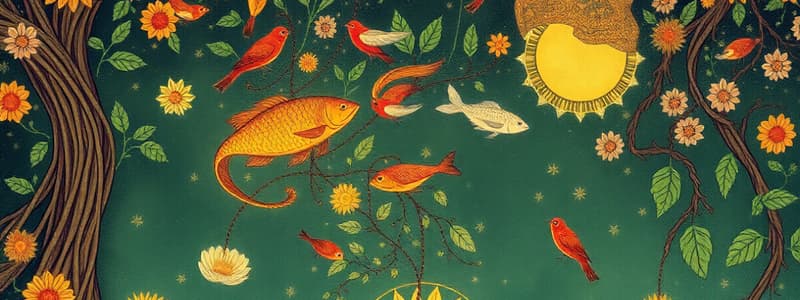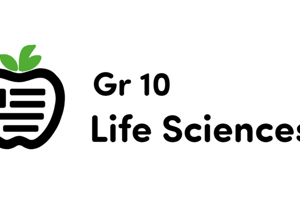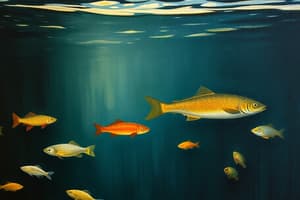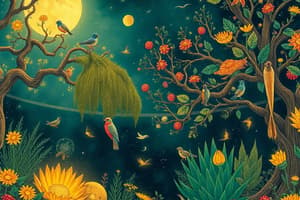Podcast
Questions and Answers
What is an ecosystem?
What is an ecosystem?
- Only the non-living things in an area
- The representation of who eats whom in an area
- The complex whole of living organisms in an area, along with their interactions (correct)
- Only the living organisms in an area
What does a food chain represent?
What does a food chain represent?
- The non-living parts of an ecosystem
- The flow of water in an ecosystem
- All the organisms in an ecosystem
- Feeding interactions in an ecosystem, showing who eats whom (correct)
In a food chain, how does energy primarily flow?
In a food chain, how does energy primarily flow?
- In one direction, from organism to organism as they eat or are eaten (correct)
- In multiple directions randomly
- In a circular pattern, constantly recycling
- From consumers back to producers
What are trophic levels?
What are trophic levels?
What are producers also known as?
What are producers also known as?
What do primary consumers primarily feed on?
What do primary consumers primarily feed on?
What do carnivores primarily eat?
What do carnivores primarily eat?
What do food webs represent that food chains do not?
What do food webs represent that food chains do not?
Approximately what percentage of energy is transferred from one trophic level to the next?
Approximately what percentage of energy is transferred from one trophic level to the next?
Which of the following is an example of a producer?
Which of the following is an example of a producer?
Flashcards
Ecosystem
Ecosystem
The complex community of organisms in an area and their interactions.
Food Chain
Food Chain
A representation of feeding relationships in an ecosystem showing who eats whom.
Producers (Autotrophs)
Producers (Autotrophs)
Organisms that create their own food using photosynthesis or chemosynthesis.
Primary Consumer
Primary Consumer
Signup and view all the flashcards
Secondary Consumer
Secondary Consumer
Signup and view all the flashcards
Tertiary Consumer
Tertiary Consumer
Signup and view all the flashcards
Quaternary Consumer
Quaternary Consumer
Signup and view all the flashcards
Herbivore
Herbivore
Signup and view all the flashcards
Carnivore
Carnivore
Signup and view all the flashcards
Omnivore
Omnivore
Signup and view all the flashcards
Study Notes
- Ecosystems encompass all organisms in an area and their interactions.
- Food chains illustrate feeding relationships within an ecosystem, showing who eats whom.
- Food chains represent feeding interactions in an ecosystem when organisms eat or are eaten.
Food Chain Examples
- A freshwater lake food chain: aquatic plants → stonefly larva → bluegill → osprey.
- A terrestrial food chain: grass → plant-eating insects → meat-eating insects → frog → snake → bird of prey.
- A marine food chain: algae → plankton → crustaceans → fish → dolphin → shark.
Energy Flow
- Energy is transferred from organism to organism through feeding.
- In the freshwater lake example, the aquatic plants used energy from the sun to create food through photosynthesis. The stonefly larva ate the aquatic plants, which means that the energy that aquatic plants contained was transferred to the stonefly.
- Energy flows in one direction, from lower to higher levels in the food chain.
Trophic Levels
- Trophic levels classify an organism's position in an ecosystem and its role in energy flow.
- Energy flows from producers to consumers.
- In the freshwater lake example, the aquatic plants produce their own food and are at the lowest trophic level or the base of the pyramid. The energy then flows to the aquatic insects, then to the bluegill that eats the aquatic insects, and finally to the osprey that eats the bluegill.
Producers (Autotrophs)
- Producers create their own food through photosynthesis or chemosynthesis.
- Photosynthetic producers use solar energy; chemosynthetic producers use chemical energy.
- Examples include algae, phytoplankton, and plants like duckweed or grass.
Primary Consumers
- Primary consumers feed on producers.
- These are exclusively herbivores.
- They occupy the second trophic level.
Secondary Consumers
- Secondary consumers feed on primary consumers.
- They can be carnivores or omnivores.
- Predators start to appear at this level.
- They make up the third trophic level.
Tertiary Consumers
- Tertiary consumers feed on secondary consumers.
- They are typically predators, either carnivores or omnivores.
- These animals occupy the fourth trophic level.
Quaternary Consumers
- Quaternary consumers are apex predators that feed on tertiary consumers and below.
- They are typically carnivores but can be omnivores.
- They are at the top of the food chain with few predators.
Herbivores
- Herbivores eat exclusively plant matter.
- Grasshoppers are primary consumers of plants.
Carnivores
- Carnivores feed exclusively on meat (other animals).
- Rat snakes eating rodents, lizards, and frogs are carnivores.
- Carnivores feed at the secondary consumer level or above.
Omnivores
- Omnivores eat both plants and meat.
- They can feed at all trophic levels from primary to quaternary consumers.
Food Webs
- Food webs represent all interconnected food chains within an ecosystem.
- They show how feeding relationships between organisms in different food chains are interconnected.
- Energy flows from producers to quaternary consumers, but not always linearly.
- Energy can flow between organisms in different food chains.
Energy Transfer Efficiency
- Energy transfer between trophic levels is not perfectly efficient.
- Typically, only 10% of energy from a lower level transfers to the next.
- The remaining energy is lost as heat, used for metabolism, or unconsumed.
- Example: If a grasshopper with 100 kJ of energy is eaten by a robin, only 10 kJ is transferred (100 kJ x 0.10 = 10 kJ).
Studying That Suits You
Use AI to generate personalized quizzes and flashcards to suit your learning preferences.




